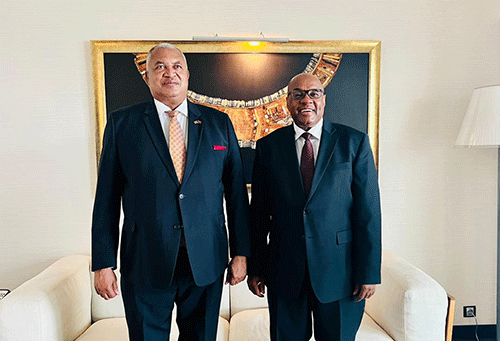After several years of planning, the Namibia Power Corporation (NamPower) has made considerable progress in the development planning for a Concentrated Solar Power (CSP) project to reduce the country’s reliance on regional electricity imports. Pending the viable feasibility of the project and requisite approvals, the CSP project award is expected in 2023 with project completion planned for 2026. This will go a long way in making Namibia self-sufficient in power generation and to reduce regional electricity imports which during 2020/21 stood at over 67%.
Responding to New Era queries, NamPower Managing Director Kahenge Haulofu, revealed that preparations for the proposed project sites started in 2015. NamPower has already received the Environmental Clearance Certificate, obtained the Transmission Offer Letter and has measured the solar resource at the proposed project sites estimated to be about half way between Windhoek and the coast.
“NamPower is in the process of finalising the acquisition of the sites with the relevant government authorises. Due to the long development times, it was decided that NamPower should commence with the development activities of the respective project sites such that the information and viability of the project can be assessed during the feasibility assessment.
“These are upfront activities that NamPower is progressing for a potential PPP (public-private-partnership) project to be led by private developers. However NamPower might end up having some kind of minority shareholding in the power plant,” Haulofu said.
The MD continued that NamPower recently appointed a Transaction Advisor (TA) to assist the corporation with the preparation of the procurement of an Independent Power Producer (IPP or private developer) through the Public Private Partnership Act.
Said Haulofu: “The first deliverable from TA is the development and compilation of a feasibility assessment for the project. Depending on the outcome of the feasibility assessment, as well as the results from the National Integration Resource Plan (NIRP); the project will be submitted to the relevant government authorities for approval and for subsequent continuation of the procurement process”.
He further explained that as part of the feasibility assessment the size, technical description and NamPower shareholding in the project will be decided.
CSP technology works by converting the sun’s irradiance into heat energy using an array of mirrors, which focus the sun’s energy onto a receiver tower or tube. Through a heat transfer process, this energy is used to raise the temperature of water to steam that consequently drives a turbine and generator to produce electricity.
With thermal storage included in the CSP plant, it can store heat for when electricity is required outside of daylight hours. Haulofu explained that the two types of CSP technology NamPower is considering is either the Parabolic Trough or the Central Receiver technology.
“As CSP technology is a renewable technology that creates dispatchable electricity with zero emissions; a key benefit for the country is the possibility of reducing electricity imports from the region and thus improving energy self-sufficiency for Namibia,” said Haulofu.
However, he added that the cost of the project would be determined by the feasibility studies to be conducted by the TA and the tenders from Private Developers (IPPs).
“As the project will be developed and procured under the Public Private Partnership Act where an Independent Power Producer (IPP) will be appointed; NamPower will procure electricity directly from the IPP,” Haulofu said.
It has also been reported that NamPower is creating a fully permitted de-risked site in the area they have been assessing for its outstanding solar resource, west of Windhoek. As part of a plan to reduce uncertainty for any potential CSP developer in the country, NamPower is now in the process of finalising a site purchase.
Namibia’s installed capacity for its population of about 2.5 million totals 579.5 MW which is mostly sourced from hydropower, renewables, neighbouring South Africa, Zimbabwe and Zambia and the Southern African Power Pool (SAPP).
The addition of dispatchable renewable technology such as CSP is anticipated to support the Namibian government’s objectives in lessening dependence on imports and coal while increasing resilience in its renewable grid. This would include low cost thermal energy storage like CSP; enabling generation on demand.
Commenting on the proposed project, Managing Consultant at RDJ Consulting, David Jarrett, said the project could provide “firm power” if combined with energy storage.
“For such a project to be considered adequate then its size would have to meet the demands of users. Self-sufficiency however needs careful alignment with current and future demand profiles being met by any planned generation regardless of technology. However, if Namibia so desires, considering cost implications etc., then CSP could be used as part of a self-sufficiency move,” said Jarrett.
He further noted that Namibia has and is contemplating a “suite” of renewable energy options that include solar photovoltaics (PV), biomass and wind technologies, all of which, when combined, offer energy security and sustainable options for the country.


